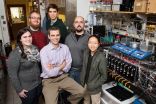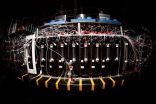Molecule-making machine simplifies complex chemistry
2015-03-12
(Press-News.org) CHAMPAIGN, Ill. -- A new molecule-making machine could do for chemistry what 3-D printing did for engineering: Make it fast, flexible and accessible to anyone.
Chemists at the University of Illinois, led by chemistry professor and medical doctor Martin D. Burke, built the machine to assemble complex small molecules at the click of a mouse, like a 3-D printer at the molecular level. The automated process has the potential to greatly speed up and enable new drug development and other technologies that rely on small molecules.
"We wanted to take a very complex process, chemical synthesis, and make it simple," said Burke, a Howard Hughes Medical Institute Early Career Scientist. "Simplicity enables automation, which, in turn, can broadly enable discovery and bring the substantial power of making molecules to nonspecialists."
The researchers described the technology in a paper featured on the cover of the March 13 issue of Science.
"Small molecules" are a specific class of complex, compact chemical structures found throughout nature. They are very important in medicine - most medications available now are small molecules - as well as in biology as probes to uncover the inner workings of cells and tissues. Small molecules also are key elements in technologies like solar cells and LEDs.
However, small molecules are notoriously difficult to make in a lab. Traditionally, a highly trained chemist spends years trying to figure out how to make each one before its function can even be explored, a slowdown that hinders development of small-molecule-based medications and technologies.
"Up to now, the bottleneck has been synthesis," Burke said. "There are many areas where progress is being slowed, and many molecules that pharmaceutical companies aren't even working on, because the barrier to synthesis is so high."
The main question that Burke's group seeks to answer: How do you take something very complex and make it as simple as possible?
The group's strategy has been to break down the complex molecules into smaller building blocks that can be easily assembled. The chemical building blocks all have the same connector piece and can be stitched together with one simple reaction, the way that a child's interconnecting plastic blocks can have different shapes but all snap together. Many of the building blocks Burke's lab has developed are available commercially.
To automate the building-block assembly, Burke's group devised a simple catch-and-release method that adds one building block at a time, rinsing the excess away before adding the next one. They demonstrated that their machine could build 14 different classes of small molecules, including ones with difficult-to-manufacture ring structures, all using the same automated building-block assembly.
"Dr. Burke's research has yielded a significant advance that helps make complex small molecule synthesis more efficient, flexible and accessible," said Miles Fabian of the National Institutes of Health's National Institute of General Medical Sciences, which partially funded the research. "It is exciting to think about the impact that continued advances in these directions will have on synthetic chemistry and life science research."
The automated synthesis technology has been licensed to REVOLUTION Medicines, Inc., a company that Burke co-founded that focuses on creating new medicines based on small molecules found in nature. The company initially is focusing on anti-fungal medications, an area where Burke's research has already made strides.
"It is expected that the technology will similarly create new opportunities in other therapeutic areas as well, as the industrialization of the technology will help refine and broaden its scope and scalability," Burke said.
"Perhaps most exciting, this work has opened up an actionable roadmap to a general and automated way to make most small molecules. If that goal can be realized, it will help shift the bottleneck from synthesis to function and bring the power of making small molecules to nonspecialists."
INFORMATION:
CONTACT: Liz Ahlberg, Physical Sciences Editor 217-244-1073; eahlberg@illinois.edu END
ELSE PRESS RELEASES FROM THIS DATE:
2015-03-12
A new study finds that Interleukin-3 (IL-3), an inflammatory factor most associated with allergic reactions, appears to have an important role in the overwhelming, life-threatening immune reaction called sepsis. In the March 13 issue of Science, investigators from Massachusetts General Hospital (MGH) describe finding that the presence of IL-3 is essential to the development of sepsis in a mouse model of the condition and that IL-3 levels in human patients with sepsis are higher in those at greater risk of dying.
"Sepsis is an extremely dangerous conditions that claims ...
2015-03-12
An international research team has shed new light on the diet of some of the earliest recorded humans in Sri Lanka. The researchers from Oxford University, working with a team from Sri Lanka and the University of Bradford, analysed the carbon and oxygen isotopes in the teeth of 26 individuals, with the oldest dating back 20,000 years. They found that nearly all the teeth analysed suggested a diet largely sourced from the rainforest.
This study, published in the early online edition of the journal, Science, shows that early modern humans adapted to living in the rainforest ...
2015-03-12
An international study involving the University of Southampton suggests there could be a rise in measles cases of 100,000 across the three countries most affected by the Ebola outbreak in West Africa due to health system disruptions.
The research in the journal Science, led by Princeton and Johns Hopkins University in the USA, predicts that the size of a measles outbreak will increase from 127,000 at the start of the Ebola epidemic in early 2014, to 227,000 after 18 months of the outbreak. This would result in an additional 5,000 measles deaths, and potentially as many ...
2015-03-12
Irvine, Calif. - What does it mean to be happy? Is it how happy you say you are, or is it how happy you act? Previous research has found that political conservatives report being happier than political liberals. But UC Irvine psychologists have discovered that those on the left exhibit happier speech patterns and facial expressions.
"The so-called 'happiness gap' between liberals and conservatives is more complicated than we thought," said Sean Wojcik, a doctoral student in psychology & social behavior at UCI and lead author of the study, which appears this month in Science.
Prior ...
2015-03-12
This is shown in a study to be published in the renowned journal Science by a team of researchers from the Potsdam Institute for Climate Impact Research. They link the findings to changes in the Arctic caused by man-made global warming.
"When the great air streams in the sky above us get disturbed by climate change, this can have severe effects on the ground," says lead-author Dim Coumou. "While you might expect reduced storm activity to be something good, it turns out that this reduction leads to a greater persistence of weather systems in the Northern hemisphere mid-latitudes. ...
2015-03-12
CAMBRIDGE, Mass--Researchers at MIT have developed a method to stimulate brain tissue using external magnetic fields and injected magnetic nanoparticles -- a technique allowing direct stimulation of neurons, which could be an effective treatment for a variety of neurological diseases, without the need for implants or external connections.
The research, conducted by Polina Anikeeva, an assistant professor of materials science and engineering, graduate student Ritchie Chen, and three others, has been published in the journal Science.
Previous efforts to stimulate the ...
2015-03-12
SAN DIEGO (Thursday, March 12, 2015) -- If you're looking to improve your heart health by changing your diet, when you eat may be just as important as what you eat. In a new study published today in Science, researchers at San Diego State University and the Salk Institute for Biological Studies found that by limiting the time span during which fruit flies could eat, they could prevent aging- and diet-related heart problems. The researchers also discovered that genes responsible for the body's circadian rhythm are integral to this process, but they're not yet sure how.
Previous ...
2015-03-12
Howard Hughes Medical Institute scientists have simplified the chemical synthesis of small molecules, eliminating a major bottleneck that limits the exploration of a class of compounds offering tremendous potential for medicine and technology.
Scientists led by Martin Burke, an HHMI early career scientist at the University of Illinois at Urbana-Champaign, used a single automated process to synthesize 14 distinct classes of small molecules from a common set of building blocks. Burke's team envisions expanding the approach to enable the production of thousands of potentially ...
2015-03-12
Boston, Mass., USA - Today at the 93rd General Session and Exhibition of the International Association for Dental Research, researcher Michael L. Meier, Center for Dental Medicine, University of Zürich, Switzerland, will present a study titled "Distinct Brain Mechanisms Related to Dental Pain Relief." The IADR General Session is being held in conjunction with the 44th Annual Meeting of the American Association for Dental Research and the 39th Annual Meeting of the Canadian Association for Dental Research.
Local anesthesia has made life more comfortable for dental ...
2015-03-12
The mechanism that causes high-performance athletes to "feel the burn" turns out to be the culprit in what makes people with chronic fatigue syndrome feel exhausted by the most common daily activities, new University of Florida Health research shows.
Published in the February issue of the journal Pain, the study shows that the neural pathways that transmit feelings of fatigue to the brain might be to blame. In those with chronic fatigue syndrome, the pathways do their job too well.
The findings also provide evidence for the first time that peripheral tissues such as ...
LAST 30 PRESS RELEASES:
[Press-News.org] Molecule-making machine simplifies complex chemistry



